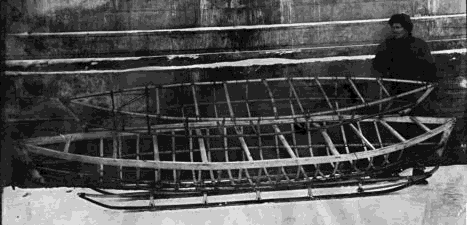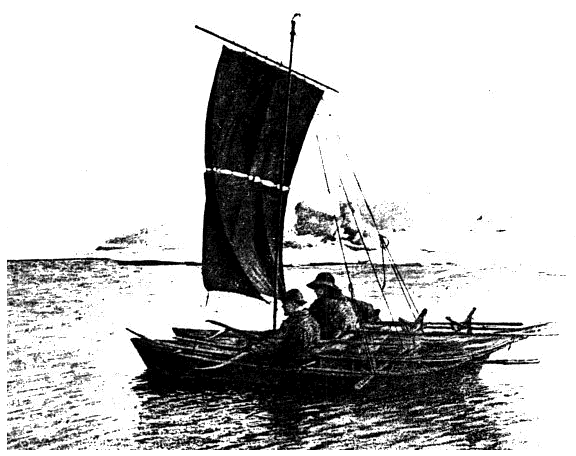
Fridtjof Nansen's Bamboo-Framed Kayak
|
Fridtjof Nansen's Bamboo-Framed Kayak |
|
In his book "Farthest North", Nansen described a journey from near the North Pole south towards Spitsbergen. With his companion, Lt. Johansen, it took over a year of dog-sledding and finally kayaking solo or lashed together as a sailing catamaran to reach a scientific outpost where they met an English exploring party. Together with a group of sled dogs they had set off from his ship, the Fram, intending to reach the Pole if they could. After months of hard going they turned back. There were two small square sails for the catamaran, or for sailing the sleds over ice. The mast and crossbeams on the cat appear to have been bamboo, too. See "Farthest North" for photos and drawings of the journey. I
have here the one of the kayak and a two-man umiak (the umiaks were Fram's
lifeboats for the expedition members, if the ship were crushed in the
ice). If I can get any other good photos or drawings of the boat, I
will post them here. The sketches and drawings don't reproduce well at
all, but there is a Nansen photo archive
on the Web in Norway. If you're Norwegian, Swedish or Danish and have a
good idea of what they have at the Fram Museum, please email me! The plan is a rough draft scaled from the photo in the book as best I could manage. There seem to be three sizes of bamboo. I'd guess 3/4 to 1-inch, 1-1/4 to 1-1/2-inch and 1-3/4 to 2-inch, but I'm not sure. I try to show the sizes in the plan. Bamboo is very strong and I suspect you could build a boat
this small using only 3/4-inch (18mm) culms [poles] and be quite cozy
in protected water. |
|
|
Part
Bamboo Diameter
Large
Large
Medium
Medium
Small
Small
Large bamboo or wood.
|
Modern builders would probably use
Dacron or nylon skin, but canvas works. So will varnished paper (see
the Links on the main Cheap Page for
paper canoes) and so would, I suspect, Tyvek or polytarp. My prototype
will use polytarp because it's so cheap and because I can paddle in
areas where it's not even over my head at high tide. Other notes:
From Vernon Doucette: For those who might be interested in pursuing information on the Nansen bamboo kayaks, the two institutions that might be worth contacting are: Norsk Sjofartsmuseum This museum holds the plans for the Fram, the Gjoa, and the Maud. These are the ships Nansen and Admundsen used on their Arctic trips. They might well have some information or photos on the kayaks. Polarskipet Fram The central exhibit is the Fram itself and by report the kayaks used on the "Farthest North" trip. |
|
For more: ***
|
|
Excerpts from "Farthest North". Read the whole story in:
Vol. 2, Farthest North, pp. 12ff
"I have already mentioned that at the end of the summer I had begun to make a kayak for a single man, the frame of which was of bamboo carefully lashed together. It was rather slow work, and took several weeks, but it turned out both light and strong. When completed the frame-work weighed 16 pounds. It was afterwards covered with sail-cloth by Sverdrup and Blessing, when the whole boat weighed 30 pounds. After finishing this I had intrusted Mogstad with the task of building a similar one. Johansen and I now set to work to make a cover for it. These kayaks were 3.70m (12ft) long, about 0.7m (28 inches) wide in the middle, and one was 30cm (12in) and the other 38cm (15in) deep. This is considerably shorter and wider than an ordinary Eskimo kayak and consequently these boats were not so light to propel through the water. But as they were chiefly intended for crossing over channels and open spaces in the ice, and coasting along possible land, speed was not of much importance. The great thing was that the boats should be strong and light, and should be able to carry, in addition to ourselves, provisions and equipment for a considerable time. If we had made them longer and narrower, besides being heavier they would have been more exposed to injury in the course of transport over the uneven ice. As they were built they proved admirably adapted for our purpose. When we loaded them with care we could stow away in them provisions and equipment for three months at least for ourselves, besides a good deal of food for the dogs; and we could, moreover, carry a dog or two on the deck. In other respects they were essentially like the Eskimo kayaks, full decked, save for an aperture in the middle for a man to sit in. This aperture was encircled by a wooden ring, after the Eskimo fashion, over which we could slip the lower part of our sealskin jackets, specially adjusted for this purpose, so that the junction between boat and jacket was watertight. When these jackets were drawn tight round the wrists and face the sea might sweep right over us without a drop of water coming into the kayak. We had to provide ourselves with such boats in case of having to cross open stretches of sea on our way to Spitsbergen, or, if we chose the other route, between Franz Josef Land and Novaya Zemlya. Besides this aperture in the middle, there were small trap-doors fore and aft in the deck, to enable us to put our hands in and stow the provisions, and also get things out more readily, without having to take out all the freight [through the cockpit when] what we wanted lay at either extremity. These trap-doors, however, could be closed so as to be quite watertight. To make the canvas quite impervious to water the best plan would have been to have sized it and then painted it externally with ordinary oil paint; but on the one hand, it was very difficult to do this work in the extreme cold (in the hold the temperature was -20C, or -4F) and, on the other hand, I was afraid the paint might render the canvas too hard and brittle, and apt to have holes knocked in it during transport over the ice. Therefore I preferred to steep it in a mixture of paraffin and tallow, which added somewhat to the weight of the kayaks, so that altogether they came to weigh about 36 pounds apiece."
|
|
|
 |
||
|
From the Equipment List:
"We soon came to a long pool, which it was necessary to ferry over. The kayaks were soon launched and lying side-by-side on the water, well stiffened, with the [skis] under the straps [just in front of the hatch], a thoroughly steady fleet. Then the sledges with their loads were run out to them, one forward, one astern. We had been concerned about the dogs and how we should get them to go with us, but they followed the sledges out on to the kayaks and lay down as if they had done nothing else all their lives. 'Kaifas' seated himself in the bow of my kayak and the two others astern."
"Now came the rigging of the kayaks for the voyage. Of course, the better way would have been to paddle singly, but, with the long, big sledges on the deck, this was not easy, and leave them behind I dared not; we might have good use for them yet. For the time being, therefore, there was nothing else to be done but to lash the two kayaks together side by side in our usual manner, stiffen them out with snow-shoes [skis] under the straps, and place the sledges athwart them, one before and one behind. "... we had not gone far when we discovered that the wind was so good that we ought to make use of it, and so we rigged up a sail on our fleet."
"When he had reached the edge of the water we made a paddle each from our snowshoe-staffs, to which we bound blades made of broken-off [skis]. They were a great improvement on the somewhat clumsy paddles, with canvas blades lashed to bamboo sticks."
"The wind was favorable, and although we were tired we decided to take advantage of the opportunity, have something to eat, rig up mast and sail on our canoes, and get afloat."
"One of the kayaks in which the meat had been lying was thrown half in the water, the other high up among the stones. The bears had been into them and dragged out the meat; but fortunately, they were none the worse, so it was easy to forgive the bears..."
"It has been a bad wind. Johansen discovered today that his kayak had disappeared. After some search he found it again several hundred feet off, up the beach; it was a good deal knocked about, too."
or to The Cheap Page
|
|
|
1.0 07/08/97
2.1 06/19/00
..